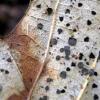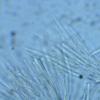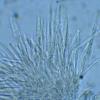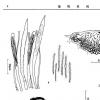
23-11-2025 11:16
Bohan JiaHi, I found small discs growing on dead stem of

21-11-2025 10:56
 Christopher Engelhardt
Christopher Engelhardt
Very small (~0,5 mm) white ascos, found yesterday

21-11-2025 11:52
Jean-Luc RangerBonjour à tous, on voit toujours 2 espèces areni

14-11-2025 16:26
 Marian Jagers
Marian Jagers
Hello everyone, On dead wood of Cytisus scoparius

17-11-2025 21:46
Philippe PELLICIERBonjour,Récolté sur bois pourrissant de feuillu
Dimorphic asci?
Masanori Kutsuna,
22-07-2015 05:34
Hello,
Coccomyces dimorphus, described by Liang et al. (Mycosystema, 19(1), p. 3-6, 2000),
has two types of asci (normal cylindrical and lanceolate) in a ascocarp.
Does anyone know other discomycetes having such dimorphic asci?
Kutsuna
Hans-Otto Baral,
22-07-2015 06:43

Re : Dimorphic asci?
This needs a closer look. I rather suspect that this fungus has dimorphic paraphyses. Asci with such acute tips seem to me impossible for any spore discharge. Did you observe any amyloidity of the asci?
A close study of the acus base woud perhaps clarify. Asci and paraphyses emerge from two separate hyphal systems. Often the ascogenous system carries croziers, the paraphysogen never.
Another possibility would by intrahymenial parasitism by another ascomycete, but this seems to me rather unllikely.
If you have a a pdf of the Liang paper I would be happy to see it. You could, e.g., attach as a nouveau fichier.
Zotto
A close study of the acus base woud perhaps clarify. Asci and paraphyses emerge from two separate hyphal systems. Often the ascogenous system carries croziers, the paraphysogen never.
Another possibility would by intrahymenial parasitism by another ascomycete, but this seems to me rather unllikely.
If you have a a pdf of the Liang paper I would be happy to see it. You could, e.g., attach as a nouveau fichier.
Zotto
Masanori Kutsuna,
22-07-2015 07:01
Re : Dimorphic asci?
Thank you, Zotto
Both type asci inamyloid, and I can't see croziers.
In Liang's paper, paraphyses are "rare", I can't observe thread-like paraphyses.
I send Liang's paper ?mainly in Chinese??by e-mail.
Kutsuna





